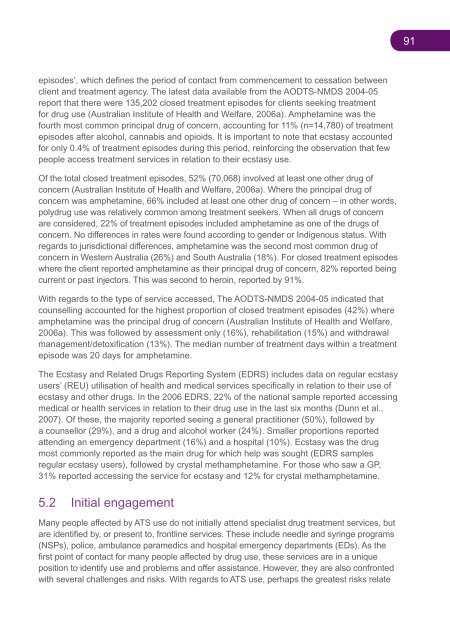National Amphetamine-Type Stimulant Strategy Background Paper
National Amphetamine-Type Stimulant Strategy Background Paper
National Amphetamine-Type Stimulant Strategy Background Paper
You also want an ePaper? Increase the reach of your titles
YUMPU automatically turns print PDFs into web optimized ePapers that Google loves.
91<br />
episodes’, which defines the period of contact from commencement to cessation between<br />
client and treatment agency. The latest data available from the AODTS-NMDS 2004-05<br />
report that there were 135,202 closed treatment episodes for clients seeking treatment<br />
for drug use (Australian Institute of Health and Welfare, 2006a). <strong>Amphetamine</strong> was the<br />
fourth most common principal drug of concern, accounting for 11% (n=14,780) of treatment<br />
episodes after alcohol, cannabis and opioids. It is important to note that ecstasy accounted<br />
for only 0.4% of treatment episodes during this period, reinforcing the observation that few<br />
people access treatment services in relation to their ecstasy use.<br />
Of the total closed treatment episodes, 52% (70,068) involved at least one other drug of<br />
concern (Australian Institute of Health and Welfare, 2006a). Where the principal drug of<br />
concern was amphetamine, 66% included at least one other drug of concern – in other words,<br />
polydrug use was relatively common among treatment seekers. When all drugs of concern<br />
are considered, 22% of treatment episodes included amphetamine as one of the drugs of<br />
concern. No differences in rates were found according to gender or Indigenous status. With<br />
regards to jurisdictional differences, amphetamine was the second most common drug of<br />
concern in Western Australia (26%) and South Australia (18%). For closed treatment episodes<br />
where the client reported amphetamine as their principal drug of concern, 82% reported being<br />
current or past injectors. This was second to heroin, reported by 91%.<br />
With regards to the type of service accessed, The AODTS-NMDS 2004-05 indicated that<br />
counselling accounted for the highest proportion of closed treatment episodes (42%) where<br />
amphetamine was the principal drug of concern (Australian Institute of Health and Welfare,<br />
2006a). This was followed by assessment only (16%), rehabilitation (15%) and withdrawal<br />
management/detoxification (13%). The median number of treatment days within a treatment<br />
episode was 20 days for amphetamine.<br />
The Ecstasy and Related Drugs Reporting System (EDRS) includes data on regular ecstasy<br />
users’ (REU) utilisation of health and medical services specifically in relation to their use of<br />
ecstasy and other drugs. In the 2006 EDRS, 22% of the national sample reported accessing<br />
medical or health services in relation to their drug use in the last six months (Dunn et al.,<br />
2007). Of these, the majority reported seeing a general practitioner (50%), followed by<br />
a counsellor (29%), and a drug and alcohol worker (24%). Smaller proportions reported<br />
attending an emergency department (16%) and a hospital (10%). Ecstasy was the drug<br />
most commonly reported as the main drug for which help was sought (EDRS samples<br />
regular ecstasy users), followed by crystal methamphetamine. For those who saw a GP,<br />
31% reported accessing the service for ecstasy and 12% for crystal methamphetamine.<br />
5.2 Initial engagement<br />
Many people affected by ATS use do not initially attend specialist drug treatment services, but<br />
are identified by, or present to, frontline services. These include needle and syringe programs<br />
(NSPs), police, ambulance paramedics and hospital emergency departments (EDs). As the<br />
first point of contact for many people affected by drug use, these services are in a unique<br />
position to identify use and problems and offer assistance. However, they are also confronted<br />
with several challenges and risks. With regards to ATS use, perhaps the greatest risks relate

















